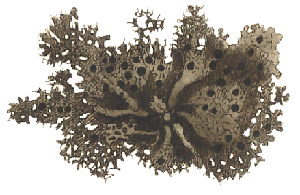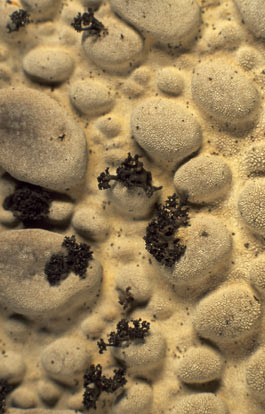 Reproduction and dispersal
Reproduction and dispersal
Sexual vs. vegetative
Sexual reproduction is neither better nor worse than vegetative reproduction. They often play different roles and, when both methods are present in a species, the two are best viewed as complementary. The Lasallia pustulata example at the end of this page is a good example of such complementarity.
The major role of sexual reproduction is the creation of genetic diversity. A genetically diverse population is more likely to contain at least some individuals able to survive environmental changes. Sexual spores are generally smaller than vegetative propagules and are often able to be dispersed long distances by wind. Wind-dispersed spores may be spread in many directions and land in habitats quite different from those where the spores were produced. The presence of genetic diversity in sexual spores would improve the chances of at least some being able to germinate and thrive in their new habitats.
The larger the propagule the shorter the distance it can be carried easily by wind. Many soredia are small enough to be wind-dispersed long distances but fragments and isidia are far more likely to be carried only short distances away from their parent thalli. That is not a sign of dispersal failure. It is clear that if a thallus has grown in a particular location the genetic makeup of that thallus is well-suited for surviving in that location. The short-distance dispersal of symbiotic propagules is a means by which that thallus is able to colonize more of the nearby area and those propagules are helping to perpetuate that successful genetic mix in the neighbourhood. It's obvious that the greater the spread of thalli in a neighbourhood the greater the chances of at least some being clear of any local disturbances (such as a burrowing wombat or a fallen tree). An obvious advantage of a symbiotic vegetative propagule is that it could start developing into a new thallus soon after coming to rest, whereas a sexual spore must associate with a suitable photobiont. The dispersal of numerous symbiotic asexual propagules nearby would be a quick means of colonizing the neighbourhood.
The absence of any need to find a partner also means that symbiotic vegetative propagules are likely to be more effective than sexual spores where a sterile landscape is being colonized. Striking examples of sterile landscapes are new volcanic islands and the extensive ash or lava deposited after a major terrestrial volcanic eruption. In the former, barren land has emerged from the sea and in the latter the volcanic deposits will have killed all life over a large area and left a bare surface for re-colonization. Extensive, high-intensity bushfires are also effective sterilizers and other, less dramatic, examples of disturbances that expose bare surfaces for recolonization are landslides and earth-moving during road works. It is often the case that species which produce soredia are the first colonizers of such areas. There is another fact that shows an advantage of lightweight asexual propagules, such as soredia, over sexual spores. There are a number of so-called species pairs of ascolichens in which the species are very similar in all respects except that one of the pair is known to reproduce only vegetatively and the other via ascospores (and no production of any specialized vegetative propagules). Amongst the pairs in which the vegetatively reproducing species reproduces via soredia, the sorediate species typically is much more widely distributed than the ascospore-producing species, even if ascospores are produced in abundance. In some cases the sorediate species can be found on more than one continent whereas the other of the pair is confined within one continent. The concept of species pairs was developed many decades ago, long before the advent of DNA analysis. Over the past decade or so DNA analyses of various species pairs have shown that various pairs cannot be considered as separate species. Rather, for some species pairs there is really just the one species with both sexually and vegetatively reproducing forms. Such findings obviously have taxonomic implications but do not invalidate the above observation about the benefits of soredia for the long-distance dispersal of a species.
Lasallia pustulata: isidia earlier, ascospores later
I'll finish this page with an example that shows the complementary roles of vegetative and sexual reproduction. The northern hemisphere species Lasallia pustulata follows a two-step reproductive strategy: vegetative early, sexual later. The foliose thalli grow on rock and are umbilicate, that is they are attached only centrally to their substrates. Populations are typically dense and exclude other species. Apart from its central attachment point a thallus is raised a few millimetres above the substrate, thereby effectively absorbing all the incident light and inhibiting any light-dependent organism from establishing itself on the rock surface below the thallus.
This species reproduces vegetatively by coralloid isidia (picture right) and sexually by ascospores. Young thalli reproduce only vegetatively whereas older thalli produce both ascospores and isidia. The isidia are brittle and easily broken by raindrops or strong winds. Their coralloid form leads to the isidia being easily trapped by any substrate irregularities and probably they are dispersed mostly just short distances downward by rainwater. Thus once a Lasallia pustulata thallus has begun to produce isidia the vegetative progeny of that thallus would tend to colonize the areas lower down. As thalli grow they compete for space and light, more fiercely as the thalli become more crowded, and there is ongoing weeding out of the 'losers'. Early production of isidia is an excellent strategy for occupying additional space on a rock but once competition has become too fierce a better strategy would be to put effort into producing wind-dispersed ascospores that could be dispersed further afield![]() .
.
Reproduction & dispersal pages on this website |
![An Australian Government Initiative [logo]](/images/austgovt_brown_90px.gif)


